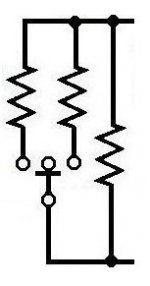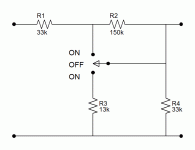There's this 3 position switch toggle I will need to use to select between three gain options.
What I never remember is if that switch should be on-none-on, on-off-on or on-on-on.
I don't think the latter is necessary, because then the arrangement would be different. On-on-on switches are usually more expensive too.
The way it is, the "external" resistor will be in parallel with the other resistors when the switch is to the right or to the left, and set the gain when the switch is in the mid position.
Can someone remind me which is the one to use here?
Thanks.
What I never remember is if that switch should be on-none-on, on-off-on or on-on-on.
I don't think the latter is necessary, because then the arrangement would be different. On-on-on switches are usually more expensive too.
The way it is, the "external" resistor will be in parallel with the other resistors when the switch is to the right or to the left, and set the gain when the switch is in the mid position.
Can someone remind me which is the one to use here?
Thanks.
Attachments
There's this 3 position switch toggle I will need to use to select between three gain options.
What I never remember is if that switch should be on-none-on, on-off-on or on-on-on.
I don't think the latter is necessary, because then the arrangement would be different. On-on-on switches are usually more expensive too.
The way it is, the "external" resistor will be in parallel with the other resistors when the switch is to the right or to the left, and set the gain when the switch is in the mid position.
Can someone remind me which is the one to use here?
Thanks.
You need On-Off-On.
are essentially the same.on-none-on, on-off-on
The middle position does not connect anything to the common pole.
You look for a switching arrangement that gives one of your gain setting when the common pole is not connected.
Then you have two alternative gain settings for when the switch is in either of the ON positions.
The switch could control relays. That gives you options on how the switch position controls the gain.
Last edited:
are essentially the same.
The middle position does not connect anything to the common pole.
You look far a switching arrangement that gives one of your gain setting when the common pole is not connected.
Then you have two alternative gain settings for when the switch is in either of the ON positions.
The switch could control relays. That gives you options on how the switch position controls the gain.
On-none-On has no center position so it won't work for this application.
none = no connection. It still describes a three position switch, ON - NONE - ON
None describe a non-existent position. DPDT with only two positions.
on - none - on
is not describing a two position switch.
It is in any switch sold in North America. If there is a center position that is open to all connections it will be marked off. If it is maked none, the position doesn't exist.
Not quite - you will see the "off" and "none" terminology conflated here:It is in any switch sold in North America. If there is a center position that is open to all connections it will be marked off. If it is maked none, the position doesn't exist.
T108MH9ABE C&K Components | Mouser.
It was once normal to describe a switch like this as just SPDT-centre off or DPDT-centre off etc. Forget the various international technical description conventions as these switches have been listed as described in standard C&K catalogues as "centre-off" double pole toggle switches for 40 years or more. The description by which you buy a product is what counts and no one sells "on-off-on" switches.
Of course these can be wired as a sequential 3 step attenuator, as audiofan's circuit shows.
Not quite - you will see the "off" and "none" terminology conflated here:
T108MH9ABE C&K Components | Mouser.
It was once normal to describe a switch like this as just SPDT-centre off or DPDT-centre off etc. Forget the various international technical description conventions as these switches have been listed as described in standard C&K catalogues as "centre-off" double pole toggle switches for 40 years or more. The description by which you buy a product is what counts and no one sells "on-off-on" switches.
Of course these can be wired as a sequential 3 step attenuator, as audiofan's circuit shows.
I've ordered 4 pin capacitors from Mouser that have 5 pins on them. Their part descriptions aren't worth the time it takes to read them. You need to go by the data sheet if you are lucky enough for them to point you to the right one.
The two main switch manufacturers I use are Carling and Cole Hersee. Neither give an actual switch position description in their catalogues. A three position switch with center off is marked on-off-on. A two position double throw switch is marked on-none-on. They both sell on-off-on switches.
The issue is confusing indeed. I selected an NKK toggle, which for exactly the same switch model it's quoted as On-On and On-None-On.
That means it has no center position so it's the wrong one for your application.
Mouser stocks C&K miniatures in pc mount with gold contacts. They're only a couple dollars. Just don't trust their description.Well, it seems the question is on looking at the manufacturer's datasheet, and see which one is which.
In my case, I'm also looking at direct pcb soldering types, which are not usually stocked.
They are expensive too. That might be a part to get a China supplier for.
- Status
- This old topic is closed. If you want to reopen this topic, contact a moderator using the "Report Post" button.
- Home
- Amplifiers
- Solid State
- Toggle switches

